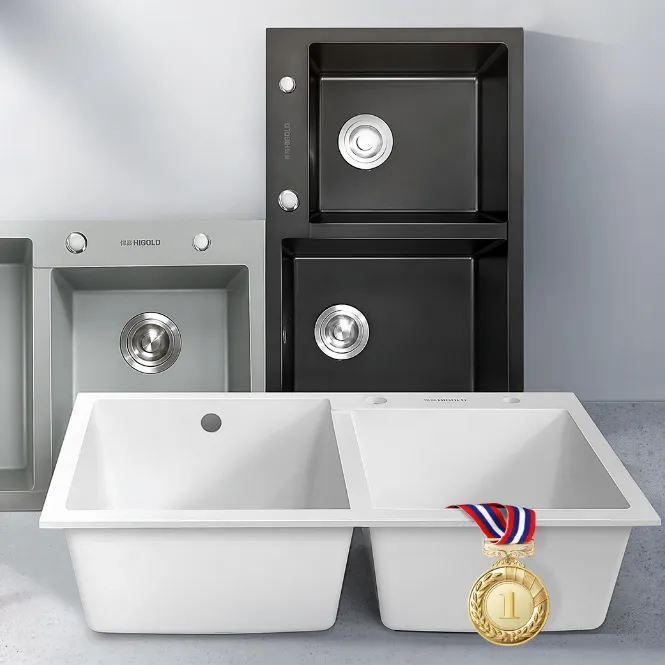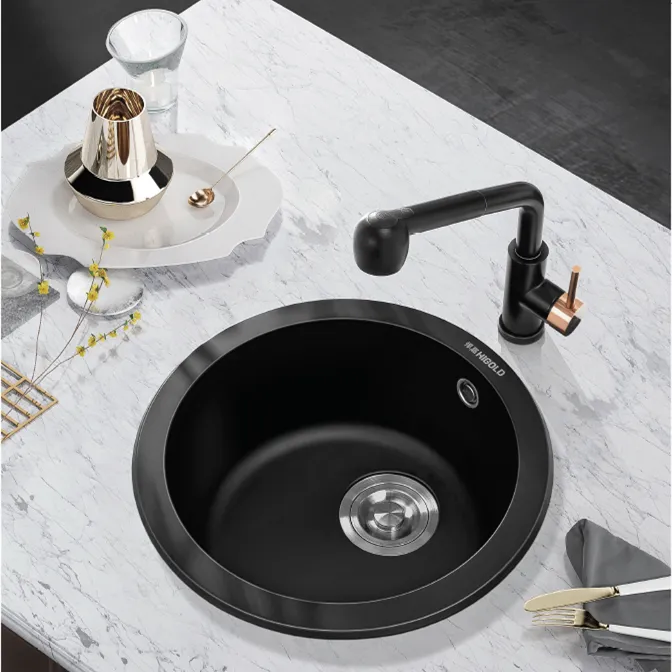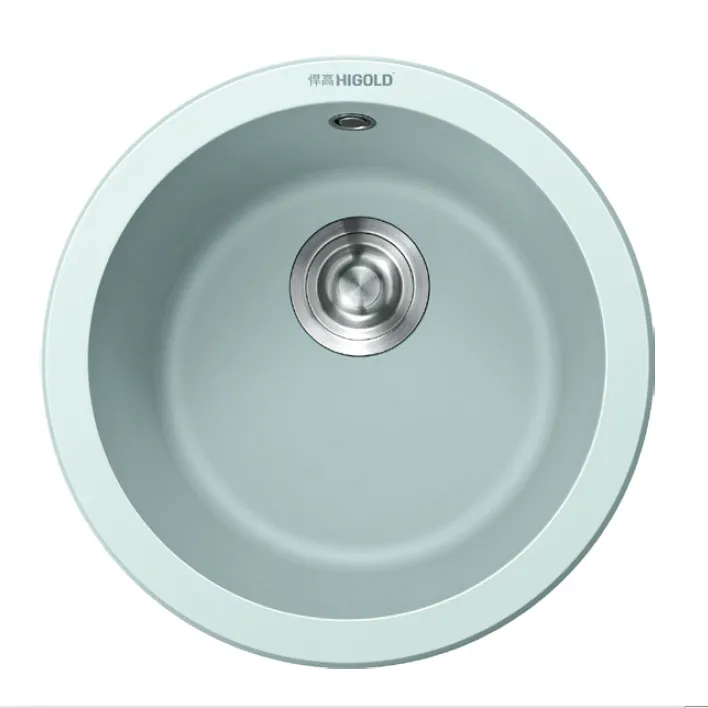As an essential kitchen fixture, the kitchen sink significantly impacts its functionality, practicality, and aesthetics. With the continuous expansion of kitchen design concepts and product variety, sink styles are also becoming more diverse. In particular, the two most popular designs, round and square, have taken a prominent place in the market.
These two designs are distinct in appearance, each with its own unique advantages and disadvantages. Choosing the right sink for your kitchen has become a challenge for many consumers and kitchen renovators. So, is a round or square kitchen sink better? This article will provide a detailed comparison and analysis of these two sinks from multiple perspectives to help you make an informed decision during the design and selection process.

What are the characteristics of a round kitchen sink?
1. Design and Aesthetics
The round kitchen sink's soft, clean lines create a sense of flow and elegance. It's generally considered more modern and stylish, complementing a variety of kitchen designs. Round sinks are particularly striking in modern minimalist or European-style kitchens. Round sink designs typically lack sharp corners, making them visually more approachable and avoiding potential hazards to kitchen users.
Aesthetically, round sinks create a harmonious feel in the kitchen, making them particularly suitable for smaller spaces or those that require a more streamlined feel. The round, streamlined design allows the sink to blend more naturally into the kitchen environment, enhancing the overall aesthetic.
2. Cleaning and Maintenance
Because round kitchen sinks lack sharp corners, water and dirt flow more smoothly toward the drain. This means that dirt and grease are more easily washed away during cleaning. Therefore, round sinks are often easier to clean and maintain than square sinks, especially since dirt tends to accumulate less in the corners. Without corners, stains can be easily removed, eliminating the inconvenience of cleaning.
Furthermore, round sinks can reduce water splashing onto the outside of the sink, especially when washing large items. The rounded edges reduce the impact and rebound of water, resulting in fewer splashes.
3. Space Adaptability
While round sinks offer an elegant design, they require less space than square sinks. This is especially true for homes requiring ample washing space, as round sinks often have limited capacity, which can affect their convenience in daily use. Therefore, round sinks may not offer the same advantages as square sinks when large quantities of items need to be washed efficiently.

What are the characteristics of a square kitchen sink?
1. Design and Aesthetics
Compared to the softer shape of round kitchen sinks, square sinks have a more rigorous and structured design, presenting a clean, modern style. Square sinks often complement a variety of kitchen styles, and are particularly considered essential elements in modern minimalist or industrial styles. The more linear lines of a square sink add a sense of structure and modernity to the kitchen space.
The square sink's shape aligns more with traditional perceptions of a sink, and its structured design makes it a popular choice for kitchen renovations. Although square sinks have a simpler appearance, they are highly functional and adaptable, making them a preferred design for most kitchen spaces.
2. Cleaning and Maintenance
Because square kitchen sinks incorporate both right and sharp angles, cleaning and maintenance are relatively complex. Dirt, grease, and food debris can accumulate in corners, requiring additional cleaning effort. While some modern square sink designs have rounded corners, they can still leave some hard-to-reach areas compared to round sinks.
However, square sinks are easier to clean large items, such as pots and pans. They provide a more spacious area, allowing dishes and kitchenware to be freely arranged and washed in the sink. This is particularly advantageous for households with large wash capacity requirements.
3. Spaciousness
Square kitchen sinks typically offer more space, especially when accommodating a large number of items. Their square design provides more space than round sinks. Square sinks typically have a larger capacity, making them suitable for a wider range of kitchen tasks. For larger families with larger kitchens or those who frequently cook and clean, a square sink is undoubtedly a more suitable choice.
Furthermore, square sinks offer greater design flexibility and can be easily integrated into various kitchen countertop layouts. They coordinate with other functional areas in the kitchen, such as the countertop and stovetop, improving overall kitchen efficiency.

Is a round or square kitchen sink better?
After understanding the characteristics of round and square kitchen sinks, we will now compare and analyze them based on the following dimensions:
1. Round Sinks vs. Square Sinks: Drainage Efficiency
Because round sinks lack sharp corners, water flows more smoothly into the drain pipe, preventing stagnation and accumulation. In contrast, square sinks may accumulate more water in the corners. While this does not affect drainage function, over time, this accumulation may reduce drainage efficiency.
2. Round Sinks vs. Square Sinks: Volume and Functionality
Square kitchen sinks generally provide more usable space, especially when washing larger items such as pots and bowls. Square sinks offer a more spacious space, accommodating more items for washing. Round kitchen sinks, on the other hand, are typically smaller and suitable for simpler cleaning tasks, such as washing small bowls and plates.
3. Round Sinks vs. Square Sinks: Aesthetics and Style
The soft shape of a round kitchen sink creates a flowing and natural aesthetic, particularly suited to modern minimalist or European-style kitchens. Square kitchen sinks, on the other hand, have a more structured design, offering a clean, modern feel that suits a variety of kitchen styles. In particular, modern or industrial styles can add a sense of structure to the space.
4. Round Sinks vs. Square Sinks: Cleaning and Maintenance
In terms of cleaning, round kitchen sinks are relatively easier to clean due to their lack of sharp corners, preventing the accumulation of dirt and grease in corners. While square kitchen sinks offer a spacious design, their right angles can easily lead to dirt and grease accumulating in corners, making them slightly more difficult to clean.
5. Round Sinks vs. Square Sinks: Installation and Space Adaptability
Square kitchen sinks are easier to install in most kitchens, especially larger ones. Their regular design adapts better to various space layouts. While round kitchen sinks are beautiful, they may not be suitable for smaller kitchens due to space constraints.

What payment terms does Higold offer for international orders?
Higold provides flexible payment options such as T/T, L/C, and negotiated milestone payments for large projects. Clear invoicing and transparent financial processes ensure smooth transactions for buyers worldwide.


